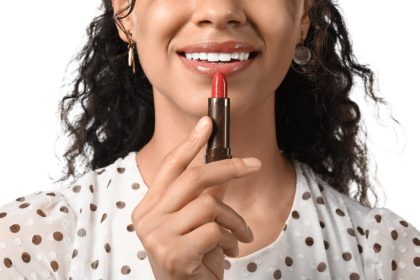That unexplained redness. The sudden breakout before an important event. The day your favorite serum suddenly feels like it’s burning. If your skin’s sensitivity seems to have mysterious ups and downs, the answer might be written in the stars—or more specifically, tied to that glowing orb controlling our tides and possibly your complexion too.
The lunar connection
The moon’s influence on Earth extends far beyond inspiring poets and werewolf legends. Its gravitational pull controls our ocean tides, affects animal behavior, and might even impact the water within our largest organ—your skin. At roughly 60% water, your skin represents a miniature ocean that could potentially respond to the same forces that move seas.
The lunar cycle takes approximately 29.5 days to complete, suspiciously similar to many biological rhythms including menstrual cycles, certain sleep patterns, and interestingly, skin regeneration cycles. This alignment isn’t just coincidental—it hints at deeper connections between celestial movements and our physiological processes.
What makes this particularly fascinating is how these lunar influences might be operating below our conscious awareness, creating patterns of skin sensitivity that seem random until viewed through the lunar calendar.
The full moon flare-up
During the full moon, when lunar gravitational pull reaches its maximum, something remarkable happens to many people’s skin. Sensitivity often increases, with previously tolerated products suddenly causing irritation, redness appearing without obvious triggers, and inflammatory conditions like eczema or rosacea potentially flaring.
This heightened reactivity might stem from subtle fluid shifts within skin tissues. Just as the moon pulls ocean tides higher, it may affect the micro-circulation and fluid balance in your skin, potentially bringing inflammatory mediators closer to the surface and increasing reactivity to environmental triggers.
The full moon phase also correlates with changes in human sleep patterns, with research showing people typically get less deep sleep during this lunar phase even in controlled environments without moonlight exposure. This sleep disruption can elevate stress hormones like cortisol, which directly impacts skin inflammation and barrier function.
The new moon renewal
In contrast to the potentially reactive full moon period, the new moon phase often coincides with a time of skin renewal and recovery. During this dark phase when the moon is positioned between Earth and the sun, many people report their skin feels more balanced, less reactive, and more receptive to treatments.
This calmer period might represent an optimal window for introducing new skincare ingredients or performing treatments that require healing time. The skin’s natural repair mechanisms may function more efficiently during this phase, with lower levels of sensitivity making it easier to tolerate active ingredients.
The new moon’s influence might also extend to our psychological state, with some people reporting lower stress levels during this phase. Since the skin-brain connection is well-established, with stress directly impacting skin barrier function and inflammation, these psychological effects could translate to measurable differences in skin sensitivity.
The waxing and waning effects
Between the extremes of new and full moon lies the waxing phase (moon growing fuller) and waning phase (moon decreasing after being full). These transitional periods bring their own patterns of skin behavior worth understanding.
During the waxing phase, as the moon grows from new to full, skin tends to gradually increase in sensitivity. This period might be ideal for gentle exfoliation and product introduction earlier in the phase, becoming more cautious as the full moon approaches. The growing lunar energy seems to parallel increasing cellular activity in the skin, potentially making it more responsive to both treatments and irritants.
Conversely, the waning phase after the full moon often brings a gradual decrease in sensitivity. This might be nature’s recovery period—a time when the skin slowly rebalances from any full moon reactivity and begins preparing for the renewal of the next new moon cycle.
The water retention reality
Beyond sensitivity, lunar cycles appear to influence skin hydration and water retention patterns. Many estheticians and dermatologists have observed increased puffiness, especially around the eyes and jawline, during the days surrounding the full moon.
This temporary fluid shift mirrors the moon’s effect on larger bodies of water. While the volume change is obviously much smaller than ocean tides, the principle remains similar—the moon’s gravitational force may affect fluid distribution within the skin and underlying tissues.
This water retention can temporarily change your facial contours, making fine lines appear less visible while potentially increasing pore visibility. Understanding this pattern can help explain seemingly random changes in your skin’s appearance and texture throughout the month.
The hormonal harmony
For people with menstrual cycles, the lunar-skin connection becomes even more intriguing. Many experience skin changes that follow both their menstrual cycle and the lunar cycle, sometimes in harmony and sometimes creating more complex patterns when the cycles don’t align.
When menstrual and lunar cycles synchronize—as they often naturally attempt to do—the effects can compound. The hormonal shifts around ovulation often align with the waxing moon phase, potentially creating a period of skin clarity and radiance. Conversely, premenstrual hormonal changes frequently coincide with the full moon, possibly explaining why some experience more dramatic skin reactivity during this time.
This dual-cycle influence helps explain why skin sensitivity patterns might seem inconsistent month to month. When tracking both cycles together, the variations often make more sense and become more predictable.
The sleep connection
The moon’s influence on skin sensitivity might operate partly through its effects on sleep quality. Multiple studies have documented changes in human sleep patterns across lunar phases, with people taking longer to fall asleep and experiencing reduced deep sleep around the full moon, regardless of light exposure.
This sleep disruption directly impacts skin health through several mechanisms. Poor sleep increases cortisol and inflammatory markers while reducing the skin’s overnight repair processes. It also affects fluid balance, potentially contributing to the under-eye puffiness many notice around the full moon.
Understanding this connection offers practical applications—being more diligent about sleep hygiene during the full moon might help mitigate some of its effects on skin sensitivity and appearance.
The practical application
Harnessing this lunar knowledge doesn’t require becoming an amateur astronomer. Simple awareness of the lunar calendar can help you anticipate sensitivity changes and adjust your skincare accordingly.
During the approaching full moon, consider simplifying your routine, avoiding new product introductions, and focusing on gentle, calming ingredients like centella asiatica, aloe, or chamomile. Schedule potentially irritating treatments like chemical exfoliation or laser procedures for the waning or new moon phases when sensitivity typically decreases.
The new moon presents an ideal window for skin renewal treatments, introducing new active ingredients, or performing more intensive procedures that require recovery time. This phase often brings the optimal balance of resilience and receptivity to maximize benefits while minimizing irritation.
The tracking benefit
Maintaining a simple skin journal alongside a lunar calendar can reveal your personal patterns. Note changes in sensitivity, breakouts, hydration levels, and overall skin appearance alongside the moon phases for several months.
This tracking often reveals surprising correlations between certain skin behaviors and specific lunar phases. While these patterns vary somewhat between individuals, most people discover consistent relationships that allow them to predict and prepare for their skin’s cyclical changes.
Many skin apps now include lunar tracking features, making this process easier than ever. Alternatively, a simple note in your calendar app marking full and new moons can provide useful reference points for understanding otherwise mysterious skin fluctuations.
The skeptic’s perspective
Of course, lunar influences on skin remain somewhat controversial in strictly scientific circles. The mechanisms aren’t fully understood, and individual responses vary significantly. Factors like geography, age, skin type, and existing conditions all influence how dramatically—if at all—someone experiences these lunar effects.
However, the absence of complete scientific explanation doesn’t invalidate the patterns observed by countless skincare professionals and individuals. Many biological rhythms were recognized through observation long before their mechanisms were understood. The lunar-skin connection may represent another case where traditional wisdom precedes scientific validation.
A balanced approach recognizes that while not everyone experiences dramatic lunar effects on their skin, being attentive to these potential patterns offers another tool for understanding and working with your skin’s natural rhythms rather than against them.

















